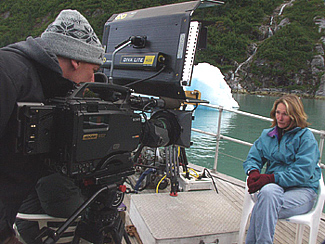Kino Flo Ideal For Studio and Location Jobs

Bill Holshevnikoff shoots an interview with whale researcher Cynthia D'Vincent, in Alaska for the documentary, "Humpbacks - Fire to Ice." ©Ross IssacsSONOMA, CALIF.
I clearly remember the very first time I worked with Kino Flo fluorescent lighting nearly 20 years ago. I was shooting a marketing piece for Infiniti cars in Los Angeles when a crew member suggested the idea of using fluorescents to light a driving scene being shot at dusk. I was curious and agreed to the idea.
We rigged the car with several Kino Flo fixtures, and to my amazement, the light was soft and natural-looking. I could choose between tungsten and daylight color balance, and the fixtures required very little power. I have been hooked on the Kino Flo product line ever since that time.
SHOOTS DEMAND DIFFERENT LIGHTS
My work as a director of photography and lighting designer varies greatly—one day I might be shooting a restaurant or spa, and another day I may be on a news set or on-location for a documentary. These different types of work can require the use of many different instruments. In general, there are tungsten lights, HMI daylight sources, fluorescents, and now LED lights. I use all of these, but on nearly every job—studio or location—I bring Kino Flo lights along. They put out a great deal of soft light relative to the power demands and I can change color temperature from tungsten to daylight in minutes without a change in light output. They're also lightweight and fast to use on set.
In the studio, Kino Flo Image-45s and ParaBeams are my first choice for the soft, base illumination I put on every set. Both are simple to install, are dimmable, and have DMX control as well. The low power consumption of these fluorescent-based instruments is an enormous advantage. I often re-place a 2,000 watt studio in-strument with a ParaBeam. The big tungsten fixtures require nearly 20 amps of power, while the ParaBeam draws only two. Also, the lamp life of Kino Flo bulbs is more than 2,000 hours, or seven times that of the average 2 kW tungsten lamp. The talent also loves the soft light from Kino Flo instruments. For multicamera productions, I often mix the soft light of Kino Flos with tungsten accent lights to create a great look on camera for news, talks shows, cooking shows and more.
IDEAL FOR LOCATION WORK
For location shooting I use Kino Flos in a variety of ways. For hotel and spa shoots, I generally use 4 Banks and the Diva-Lites. I shoot a lot of food and wine products and we often work in restaurants and kitchens where power is a concern. Once again, the low power consumption of the Kino Flos allows me to create a great look with multiple instruments without blowing circuit breakers.
For documentaries, I can choose my color temperature and work in nearly any environment. The Diva-Lite is a powerful, dimmable light source that I often use as a fill light; even outdoors for interviews.
The Kino Flo product line is a versatile, creative tool set that allows me to accomplish my work in less time and with fewer problems, and in my opinion, that should be the goal of any good tool or product.
Bill Holshevnikoff is an award-winning director of photography, lighting designer and educator. His Power of Lighting Workshops have been attended by thousands of film and video professionals. He may be contacted atbholshev@poweroflighting.com.
For additional information, contact Kino Flo Lighting Systems at 818-767-6528 or visitwww.kinoflo.com.
The professional video industry's #1 source for news, trends and product and tech information. Sign up below.
